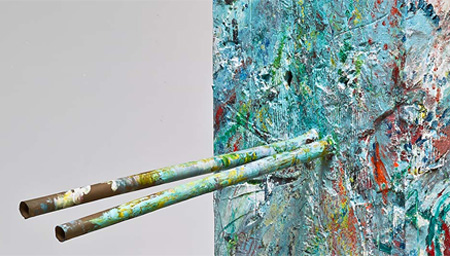Mark Grotjahn is probably best known in Dallas as the Two x Two For Aids and Art honoree who spectacularly flared out during the 2011 event, winding up by night’s end sloppily drunk and stumbling around the Rachofsky House lawn. At the time he was the picture of the artist-as-non-renewable resource, the pawn in the game of power and prestige that gobbles up the work of the soul and manufactures it into the grist of society. The photo that circulated along with Alan Peppard’s salacious report on the event conjured an image of a wild-eyed Caliban, Grotjahn’s hair flayed and tangled, like a Medusa, scowling at his paparazzo, trying to turn the world into stone.

It was a portrait of the artist as a haunted man, and, for better or worse, the incident framed my approach to the Grotjahn’s exhibition of sculptures at the Nasher Sculpture Center. Grotjahn is best known as a painter of flashy abstracts. Here he has created a dozen or so painted sculptures. They are rectangular, box-like objects made of bronze and standing upright. The front of each is flattened and punctured, and poles are crudely welded on — puncturing or protruding from the face of each. The backs are opened and exposed to the rebar substructures, web-like spines that hold together these hastily constructed things. They read like totems, or African fertility statues. The poles ward off visitors, push them back, while making the sculptures look like Pinocchio faces, or gentiles, or both. The paint is splattered and lathered on, rich and frantic. The name of the artist is scribbled on the backside, his hand prints still visible amidst the blur of color. These may be attempts at self-portraiture. They convey a sense of discord, a frantic energy – a working through that is a working out. But what is appealing about the work is the sincerity with which they lay themselves bare, conveying an inner turmoil that is vulnerable, hard-suffering, kinetic, and frank.
In the next room, German artist Bettina Pousttchi has completely transformed the Nasher gallery space by covering the floor with asphalt and street paint, and the windows with her trademark thatch work paint. The institutional takeover is full of tongue-in-cheek metaphors: the history of the Arts District as a strip of parking garages; the transient nature of museum experience, the cultural drive-by; and Dallas’ car-centric society in general. But outside of these cutesy winks, the real power of the exhibition is the way this theatrical gesture affects the experience of the space and the experience of the objects contained in it.
Pousttchi’s work is often engaged in an attempt to bring the memory of place to the forefront of experience. On a literal level, here she attempts to have us experience the Nasher both as a museum and as the parking garage that once inhabited that land, confusing those contradictory historical identities, collapsing multiple senses of time in on themselves. With regard to her consideration of time and how we experience it, the sculptures in the gallery seem carefully chosen. They represent some of the best in the Nasher collection and read as a bullet-pointed history of modern sculpture. There’s Chamberlain’s twisted auto steel, of course, but also works by Picasso, Matisse, Arp, Brancusi, and Giacometti. Each object takes on a new meaningfulness in this transformed setting. The slouching woman by Maillol appears weightier and stiller than she has on previous encounters, conjuring an intensified forlornness and feeling of being cast-off when framed between the vectoring white road dashes. But taken together, these art pieces suggest something else. Is Pousttchi using the road as a metaphor for the longitudinal or progressive construct of cultural history, and if so, what does this critique expose about the constructed-ness of history? Or is she seeking to collapse this history into a single space in order to draw-out uniform characteristics of human expression? In other words, is she disrupting the museum environment, or making us more sensitive to its particular power?

Pousttchi also has her own work in the exhibition. Her tube sculptures are scattered on the patio which overlooks the garden patio, along with a tower of steel crowd partitions, painted white and welded into a tangled mess. A similar sculpture is inside the museum gallery, and it is her best. The white crowd partitions twist upwards, and a strip of florescent lights rests in its center. I visited the Nasher in the late afternoon, when the sun reflects off Museum Tower and casts the bright dotted pattern of Renzo Piano’s oculus roof on the travertine walls. This is the chief offense of the oversized neighbor, the way the out-of-place real estate ruins the immaculate light that diffuses through Piano’s inspired design. But Pousttchi appears to be toying with this. Her sculpture is itself a tower of light, and against the backdrop of sun spots, it creates an illuminated pastiche. This accidental composition collapses the Museum Tower-effect into the aesthetics of the Nasher gallery experience, destroying delineations and forcing a messy, though exquisitely beautiful symbiosis.





